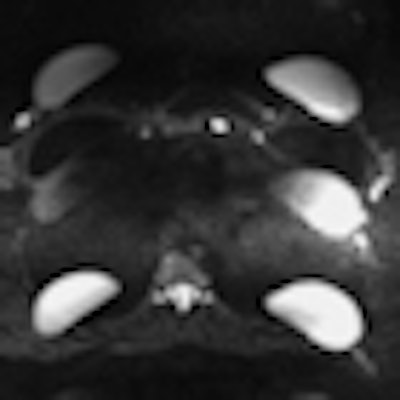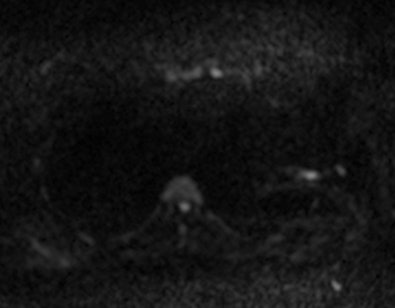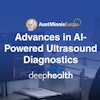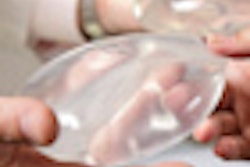
Imaging women with silicone breast implants with diffusion-weighted MR imaging (DWI) is a challenge, but a possible solution is to combine short-tau inversion recovery (STIR) and slice-select gradient-reversal (SSGR) to eliminate or reduce silicone signal, according to a study published online in European Radiologyon 16 June.
DWI is often used to detect breast diseases and also assess treatment outcomes, but in women with silicone breast implants, DWI is complex using the conventional single-shot echo-planar imaging (EPI) technique -- it's not possible to successfully suppress fat and silicone using the STIR technique on its own, making the detection of breast disease difficult.
"Protons associated with fat and silicone differ substantially in the T1 relaxation times, approximately 300 msec and 900 msec, respectively at 1.5 tesla," noted lead author Dr. Dow-Mu Koh, a consultant radiologist in functional imaging at the Royal Marsden Hospital in Sutton, U.K. "Consequently, unsuppressed silicone signal from implants results in ghosting and chemical shift artifacts at DWI, which can obscure lesions and confound interpretation."
To determine how to successfully image women with silicone breast implants using DWI, the researchers performed MRI exams at 1.5 and 3 tesla using STIR fat-suppressed EPI DWI on its own and combined with SSGR.
A 26-year-old healthy volunteer with bilateral silicone breast implants underwent MR imaging on a 3-tesla Siemens Healthcare Verio MR system using a work-in-progress software, also from Siemens. A 48-year-old woman with a history of left breast cancer treated with breast-conserving surgery and bilateral silicone implants for reconstruction was imaged at 1.5 tesla using a Siemens Avanto system.
Diffusion-weighted images acquired at 1.5 and 3 tesla were compared visually for artifacts and the degree of silicone suppression.
 Images acquired in a 26-year-old woman with normal breast implants. Above: Standard fat-suppressed single-shot EPI diffusion-weighted MR sequence at 3 tesla. There are substantial ghosting artifacts seen, which limits the usefulness of such images for disease assessment. Below: Same patient imaged using combination chemical suppression technique of STIR and SSGR. There is now complete signal suppression of both fat and silicone. Images courtesy of Dr. Dow-Mu Koh.
Images acquired in a 26-year-old woman with normal breast implants. Above: Standard fat-suppressed single-shot EPI diffusion-weighted MR sequence at 3 tesla. There are substantial ghosting artifacts seen, which limits the usefulness of such images for disease assessment. Below: Same patient imaged using combination chemical suppression technique of STIR and SSGR. There is now complete signal suppression of both fat and silicone. Images courtesy of Dr. Dow-Mu Koh.
The research team found complete suppression of the fat and silicone signal was possible at 3 tesla using EPI DWI with STIR and SSGR, evaluated with dedicated breast coils. The technique yielded high-quality, high-b-value DW-MR images and apparent diffusion coefficient maps for clinical evaluation. However, at 1.5 tesla, a residual silicone signal was still perceptible. "A further reduction in silicone signal at 1.5 tesla could be achieved by employing thinner slice partitions and the addition of the chemical selective fat-suppression technique," the authors wrote.
The researchers attest the technique doesn't work as well at 1.5 tesla because the precessional frequency of water and silicone is closer at 1.5 tesla compared with 3 tesla, resulting in greater overlap, so there is a residual silicone signal returned from the image slice interrogated by the opposing slice selective gradients. Further work to evaluate the effect of bandwidth on the SSGR pulse could help optimize silicone suppression using SSGR at 1.5 tesla, they advised.
"Based on our results, it is currently advantageous to perform clinical DWI of women with silicone breast implants at the higher field strength of 3 tesla to achieve optimum dual fat and silicone signal suppression for cancer screening or post-treatment surveillance," they wrote. "However, one disadvantage of SSGR is that it can lead to lower image signal-to-noise [ratio] in regions suffering from B0 field inhomogeneities because of imperfect shim, but this may be acceptable for detecting lesions with high intrinsic lesion-to-background contrast ratio."
The clinic value of the technique needs to be validated in future prospective studies, but there are a few factors in SSGR's favor:
- Applying SSGR in combination with STIR EPI DWI does not incur any additional time penalty compared with STIR EPI DWI on its own.
- The SSGR technique is available across different MR vendor platforms, making it possible to use a combined approach on different MR systems.
- SSGR is not fat-selective, which means applying the technique could improve background signal suppression from fat, silicone, or other chemical compounds that have a significantly different precessional frequency compared with water.
- SSGR can achieve fat and silicone suppression at higher field strengths without an increased specific absorption rate associated with adiabatic radiofrequency (RF) pulses used for spectral attenuated inversion recovery (SPAIR)- and IR-based fat/silicone suppression.
"Future work could explore the potential utility of combining SPAIR or SPIR fat suppression with SSGR," the authors wrote. "Secondly, although employing three combined fat and chemical suppression techniques with thin image sections can eliminate silicone signal at 1.5 tesla, this approach may not be clinically practical because of the long measurement time."
They also speculate future work could explore decreasing the bandwidth of the RF pulses at 1.5 tesla, which may allow more complete fat and silicone suppression using the combination of STIR and SSGR without the addition of chemical selective fat suppression.


















